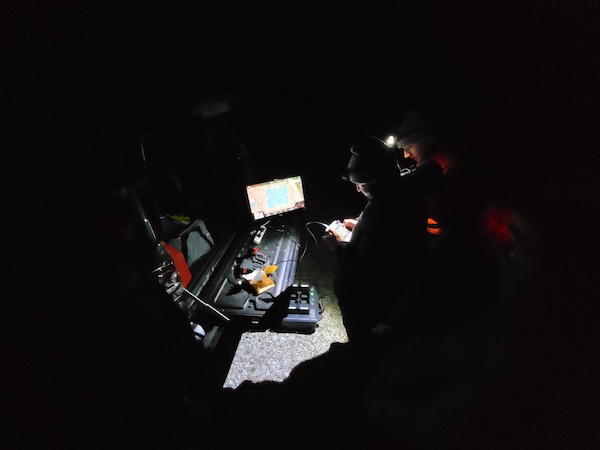Early indications are this sort of technology will be extremely useful for measuring pest abundance so we can determine the best elimination tool to be used, and for detecting the last surviving individuals and guiding efforts to remove them.
Spotting rabbits with thermal drone
Mounting a thermal camera onto a drone looks like it could be a game changer when it comes to measuring rabbits in a landscape.
The team has trialled the drone camera in various lowland areas with different rabbit abundances. Rabbits can be shy around motor vehicles and the terrain and vegetation conceal rabbits in ground-based surveys. Drones cause much less disturbance and can pick up small mammals hiding in vegetation, so appear to be a much more effective detection tool.
 Predator ecologist Nick Foster says after a bit of training they are feeling confident about the ability to accurately identify different pests. “The drone flies low to the ground so it gives us a good view of the animal and also encourages the pests to move. Identification improves greatly when you capture their movement. This obviously comes at a cost as the search area of the drone decreases the lower you fly, so it’s about finding a happy medium with the tool that you are using.”
Predator ecologist Nick Foster says after a bit of training they are feeling confident about the ability to accurately identify different pests. “The drone flies low to the ground so it gives us a good view of the animal and also encourages the pests to move. Identification improves greatly when you capture their movement. This obviously comes at a cost as the search area of the drone decreases the lower you fly, so it’s about finding a happy medium with the tool that you are using.”
The best time to use it is right before sunrise when it is coldest and the landscape has had a good chance to cool down, increasing the difference between the background temperature and the body temperature of the target species. If the night is too warm, the rocks can hold heat and be mistaken for pests like hedgehogs.
Thermal assisted hare hunting
We have also trialled thermal imaging to search for hares from helicopters in alpine areas. The team spent just under two hours in the air over a 330ha area in the Malte Brun. During that time they detected and shot 14 hares. Without the thermal image equipment the crew estimate they would have only seen one of those hares with the naked eye.
“It’s quite clear that this is a tool that is going to be part of hare elimination and we now need to investigate how effective it is at spotting the last hares,” says Nick Foster.
 Hares target sensitive alpine plant species (like scree pea) and provide a large protein source for predators like stoats in the alpine zone. The team plans to return to the Malte Brun site where they trialled the thermal equipment to see how many hares are detected and removed across repeat visits, and to measure the response in the local hare population using ground-based cameras. As the site is surrounded by mountains, the team would assume any hares still there were survivors, not invaders.
Hares target sensitive alpine plant species (like scree pea) and provide a large protein source for predators like stoats in the alpine zone. The team plans to return to the Malte Brun site where they trialled the thermal equipment to see how many hares are detected and removed across repeat visits, and to measure the response in the local hare population using ground-based cameras. As the site is surrounded by mountains, the team would assume any hares still there were survivors, not invaders.


